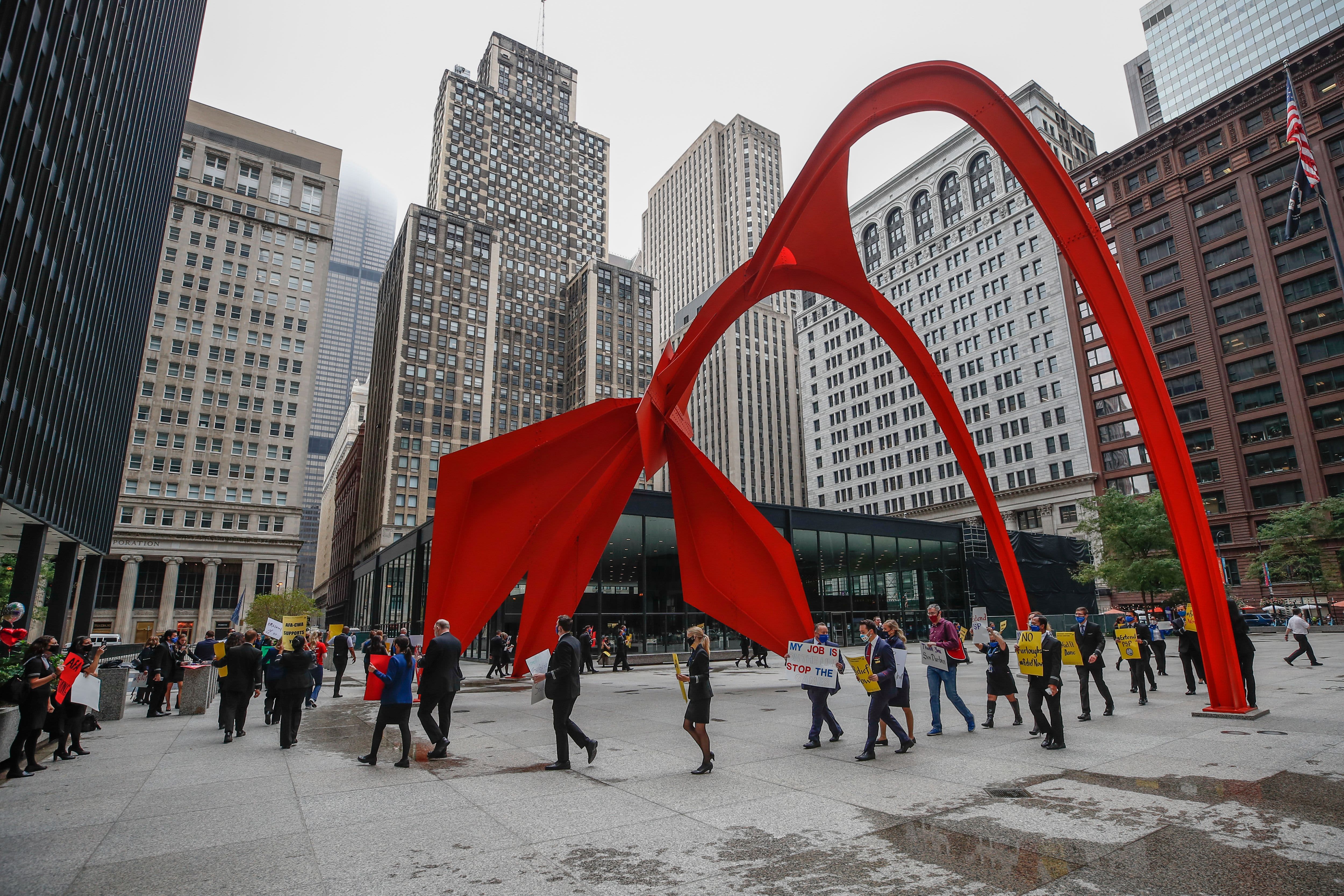Airline industry workers protest in favor of pandemic relief in Chicago’s Federal Plaza on Sep. 9, 2020.
KAMIL KRZACZYNSKI/AFP via Getty Images
Millions of Americans have headed back to work since the depths of the coronavirus-induced recession in the spring.
But nearly 13 million remain unemployed — about 7 million more workers than pre-pandemic levels.
And there are worrying trends emerging among this group. Namely, a growing share of job loss is permanent (rather than temporary) and is longer-term in nature, stretching out beyond six months.
These trends carry negative financial effects for the unemployed and their families, including lost income, reduced likelihood of finding a job and lower earnings when (and if) they get one, according to economists.
The recession has hit lower-wage workers and minorities — who are less likely to be able to withstand these financial shocks — harder than other groups.
“The impacts [this] will have on the community are tremendous,” said Behnaz Mansouri, a senior attorney with the Unemployment Law Project.
Permanent layoffs
The mass unemployment that hit in April was overwhelmingly thought to be a temporary phenomenon that would quickly rebound as businesses reopened, Mansouri said.
Nearly 4 in 5 unemployed workers — representing more than 18 million people — were on temporary layoff at the height of the unemployment crisis and expected to be recalled to work.
That number has since fallen to about 4.6 million, or about 37% of the unemployed, as of September — still higher than any period since modern record keeping began in the 1960s.
The longer you are out [of a job], the more damage it can do.
Heidi Shierholz
director of policy at the Economic Policy Institute
That dynamic of the temporarily unemployed being recalled to work is the primary reason the unemployment rate has nearly halved to 7.9% since April, according to economists.
At the time same, “permanent” job loss has been increasing. In September, the number of permanent job losses grew by 345,000 to 3.8 million, according to the Bureau of Labor Statistics. That figure exceeds pre-pandemic levels by 2.5 million people.
This suggests some layoffs once thought temporary have instead become permanent, economists said.
Further, companies have begun initiating layoffs on a trajectory similar to traditional recessions, economists said, as slowdowns in consumer demand (rather than state-mandated shutdowns) lead them to cut jobs or close for good.
Companies such as Allstate, American Airlines, Disney, Royal Dutch Shell and United Airlines have each announced plans to cut thousands of workers in recent weeks.
More from Personal Finance:
Unemployment may pay just $5 a week without stimulus deal
What Biden’s tax proposals mean for households
Amazon Prime Day is starting — here are the best deals
More than 800,000 people filed new applications for unemployment insurance last week, which, roughly seven months into the downturn, is significantly higher than the 188,000 who did so at the same time last year, according to the Labor Department.
“We’re still at a high level of layoffs in the economy,” said Susan Houseman, VP and research director at the W.E. Upjohn Institute for Employment Research. “The new job losses will, by and large, be perceived as permanent.”
Long-term unemployment
Long-term unemployment, a period exceeding six months, has increased substantially as this job loss has taken root.
Around 2.4 million Americans were unemployed for 27 weeks or more in September, up 781,000 from the month prior, according to the Bureau of Labor Statistics.
Long-term unemployment last ballooned during the Great Recession, hovering around 40% of the overall jobless population from late 2009 into 2013, according to an Urban Institute report. It had never previously risen above 30% since the Great Depression, the report said. The share is currently around 19% and rising.
During the Great Recession, family incomes fell 40% or more for most long-term unemployed workers, the institute said. This makes it more likely families can’t pay their bills, stay in their home, or afford food and medicine, in addition to related but intangible negative effects like emotional and mental effects, Mansouri said.
The long-term unemployed were almost twice as likely to be poor as those jobless less than six months, and almost four times as likely to be poor as those who hadn’t become unemployed, according to the report.
Further, in late 2011, 63% reported having skipped dental visits, 56% deferring needed health care and 40% not filling a prescription, according to the report. Each instance was about twice the proportion of full-time workers.
‘More damage’
“The longer you are out [of a job], the more damage it can do,” said Heidi Shierholz, director of policy at the Economic Policy Institute, a left-leaning think tank and former chief economist at the Department of Labor during the Obama administration.
Workers’ networks of business contacts often fray, making it harder to find a new job, at a time when employers may not look favorably on hiring a candidate who’s been out of work for months, according to economists.
Similarly, workers’ skills may erode as more time passes, leading to the potential for reduced wages or difficulty finding a new job, according to the Urban Institute.
Low-wage, minority and less-educated workers have been much more likely to lose their jobs in the coronavirus recession given its outsized impact on the hospitality and service sectors.
“They don’t have savings. They don’t have reserves,” Mansouri said.
Enhanced unemployment benefits have helped make up some of the income shortfall associated with losing a job.
Workers received a $600 weekly supplement to state unemployment benefits from a federal relief package enacted in March. Without that enhancement, which ended in July, unemployment benefits pay about 39% of workers’ prior paychecks on average, according to the Labor Department.
A Trump administration program created in August paid up to $1,800 in extra federal benefits to workers. But that benefit has ended in many states.
Lawmakers have been debating the contours of another relief package for weeks but remain in limbo as to whether any additional aid is coming.
